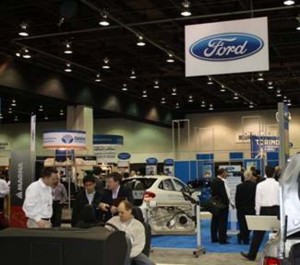
The annual gathering of auto engineers, the SAE World Congress, has been shrinking for years. But the 2010 event was intentionally downsized, claim its organizers.
If the SAE World Congress looked smaller to those attending the industry’s premier automotive engineering event at Detroit ‘s Cobo Center earlier this month, that’s because it was smaller – by design, according to conference organizers, though recent history shows the once massive event has been shriveling on its own for a number of years.
Some 300 companies exhibited at the event last year but the 2010 World Congress saw just 103 firms on the floor, according to Andrew Brown Jr., chief technologist at Delphi Corporation and president of the SAE for 2010. The number of papers presented at the conference was smaller, as well – about 1,090 versus 1,370 in 2009 – and attendance was down from 16,000 to somewhere beyond 10,000.
“The food court was nearly as big as the displays,” complained one participant, asking not to be named, but echoing a comment heard repeatedly during this year’s show.
Arguably the biggest changes were trimming the show from four days to three, and squeezing out exhibitors of marginal interest to time-pressed engineers.
“An industry leadership coalition helps define and shape the Congress, and this year the coalition, along with SAE, made a conscious decision to look for companies that are going to bring innovative ideas into their exhibit,” explains Mark Johnson, a vehicle integration engineering manager at General Motors who will play a key role in planning the 2011 Congress.
“A panel was put together and every exhibitor had to apply and present the cutting-edge technology they wanted to show. The number of exhibitors shrank, but at the end of the day, that was okay,” Johnson contends. “Engineers don’t have time to spend time with all of them, and it’s tough to figure out who has the interesting stuff, so their time was better managed for them. It was definitely a strategic move, and the feedback I had was that it was all positive.”
Not everyone was happy with the changes. An executive at an electronics firm who asked not to be identified says “We decided not to exhibit, not because we didn’t get accepted but because we decided that the return on investment was likely not to be worthwhile this year. The exhibit pricing was revised and the cost increased two or three times for comparable space.”
Except for automakers, who were encouraged to show off their newest vehicles, organizers capped booth sizes at 20×20, hoping to provide a more level playing field for newer companies.
“Over the past year or two the number of leads we were getting was declining, partly from the economy, and partly from the unwieldiness that SAE was starting to experience – too big, and unfocused, because there were so many things going on there,” the executive adds.
“The whole examination of the Congress had to do with value,” says Delphi’s Brown. “We stepped away from emphasis on having more for the sake of having more. The industry is going through a transformation, and discretionary dollars have diminished. We need to recognize that, and to assure that we are delivering value for whatever investment is made.
“Attendance was over 10,000, and that beat our expectations because of the economy and because of where the industry is,” Brown adds. “We did not expect to get 10,000 people there. We were very pleasantly surprised that the numbers steadily increased.”
Brown says conference planners focused on innovation and technology, enhancing networking, and providing alternative ways of obtaining technical information. “Reducing the Congress from four days to three allowed us to really focus on enhancing value; delivering quality as opposed to quantity. We eliminated the need to fill up four days with ‘stuff.’”
“We could see what was happening in the industry with the crisis, and we had to step up our game in the way we engaged our customers,” notes Patti Kreh, who manages SAE meetings. “We conducted focus groups with attendees, exhibitors, and sponsors, and they told us they couldn’t support the Congress as it had been. The industry was consolidating and engineers needed new ways of gathering the information they need to do their jobs.”
Kreh cites “Chat with the Experts” as one new information-sharing medium. “It was a facilitated chat with recognized experts, and some of them were so successful we had to move some to larger rooms,” she says. “They spawned impromptu sessions in technology lounges, which were also new. We wanted to provide structured ways that people with interest in specific tracks – like electronics, emissions, or manufacturing – could identify their peers. Badges were color-coded, we published a list of attendees with subject matter interest, and we set aside specific lounges for them.”
“I sensed a spirit of optimism and a renewed spirit in the industry that things are turning around; that things are changing,” says Delphi’s Brown. “All of the OEMs are indicating improvement. They are out there hiring in focused ways. Things are moving ahead in the industry and people are walking with their heads up now and not looking at their shoes as we have been doing. The best testament will be comparing the 2010 World Congress to 2011 going forward.”
